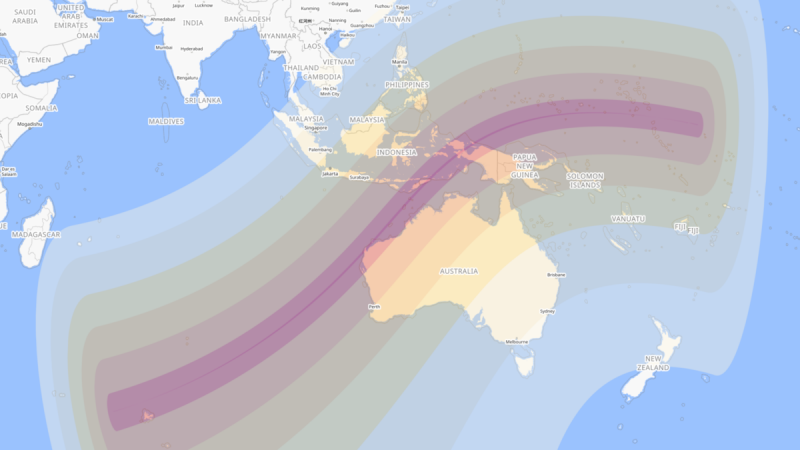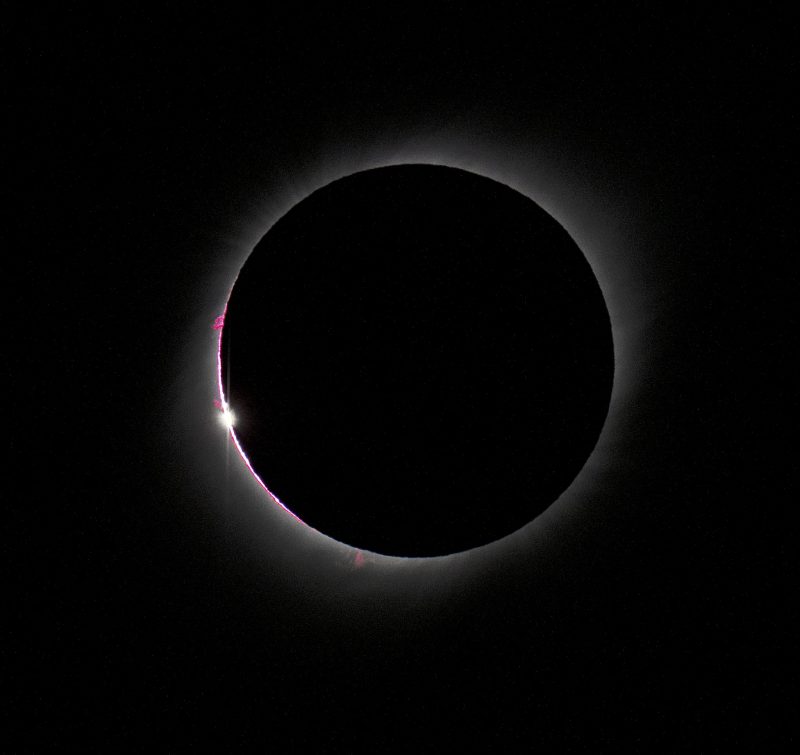
Graham Jones at timeanddate.com posted this original article on April 4, 2023. Edits by EarthSky.
When is the April 2023 solar eclipse, where does it happen, and how can you watch it? Plus, what makes this eclipse so special? Read on for 10 things to know about the upcoming solar eclipse.
1. A once-every-10-years eclipse
On April 20, 2023, the moon will cross the face of the sun, and a solar eclipse will sweep through Australia and Southeast Asia. The total phase of the eclipse, where the moon blocks all of the sun’s disk, appears to those along a narrow path of totality that stretches from the Indian Ocean to the Pacific.
At either end of this path, the curvature of the Earth increases the distance between the moon and the observer. The moon is then too small to cover the sun completely. As a result, in these locations (which are out over the ocean), the eclipse will appear to be annular, where the sun forms a ring around the moon.
This is called an annular-total eclipse or hybrid eclipse. It’s a little unusual but not particularly rare. The last one occurred in November 2013; the next one will happen in November 2031.
2. Who gets totality?
The path of totality passes over three countries: Australia, East Timor and Indonesia. In Australia, the path of totality just nicks a small peninsula called North West Cape, about 700 miles (1,100 km) north of Perth.
The rest of Australia and a big portion of Southeast Asia will see a partial solar eclipse, where the moon covers some, but not all, of the sun. For Perth, the moon will cover 71% of the sun. In Sydney, this figure will be 10%; in Singapore, it will be 16%.

3. A golden era for Australia
This eclipse kicks off a remarkable run of five total solar eclipses for Australia in 15 years:
See a list of all eclipses from 1900 to 2199.
4. A partial eclipse for almost 1 in 10 people
According to our population figures – calculated using raw population data from the Center for International Earth Science Information Network (CIESIN) at Columbia University – a grand total of around 375,000 Australians, Timorese and Indonesians live in the path of totality for the April 20 eclipse.
This is a relatively small number, roughly the same as the number of people who live in the city of Bakersfield, California.
How many people live in the area of the globe covered by a partial eclipse? That’s a completely different number: around 693 million people, roughly 9% of the world’s population.
5. Crowds in North West Cape
Australia’s North West Cape is sparsely populated. Only 3,000 or so people live in Exmouth, the largest town on the peninsula. However, thousands of visitors will likely flock to the town for the eclipse.
Exmouth will have 58 seconds of totality on April 20, starting at 11:29 in the morning, local time.
6. Totality passes over a solar observatory
Learmonth Solar Observatory lies about 18 miles (30 km ) south of Exmouth. Jointly operated by the Australian government and the United States Air Force (USAF), it monitors emissions from the sun that can affect things like radio communication, satellites and auroras.
Major Coy Fischer, who spent two years at Learmonth as the USAF Unit Commander, said:
The space environment is much harsher than people realize.
7. A hybrid eclipse can produce a unique sight
During a hybrid eclipse, it’s not possible for a single observer to see both a total and an annular eclipse. It’s either one or the other, depending on where the observer is along the eclipse path.
There are, however, points where the moon appears to be exactly the same size as the sun. What does that look like? During a hybrid eclipse midway between Iceland and Greenland on October 3, 1986, astronomer Glenn Schneider captured photos from a plane flying at 40,000 feet (12,000 meters). See his photos here.
Schneider said:
Clearly, this eclipse was not annular. [At the same time] some have argued it was not total as the photosphere was never instantaneously completely extincted.
8. This new moon precedes the end of Ramadan
The holy month of Ramadan – a time of fasting and prayer for Muslims around the world – starts and finishes with the appearance of a waxing crescent moon after the new moon phase.
This year, depending on the country, Ramadan began on March 23 or 24, following the new moon of March 21.
It will end – again, depending on the country – on April 21, 22 or 23, following the new moon of April 20. This is the same new moon that will produce the solar eclipse across Indonesia, the world’s most populous Muslim country.
9. Watch the eclipse live
As always, timeanddate.com will be streaming the eclipse live. Steffen Thorsen – timeanddate’s CEO and Chief Eclipse Chaser – will join Matt Woods of Perth Observatory at a site around 13 miles (20 km) south of Exmouth.
Weather permitting, Steffen and Matt’s telescopes and cameras will capture about 1 minute and 3 seconds of totality. The live show starts at 01:30 UTC on April 20.
This is the sixth time that timeanddate has teamed up with Perth Observatory for an eclipse live stream.
10. Eye safety is important
Be serious about eye safety. Never look at the sun without proper eye protection. Learn how to use eclipse glasses, and how to know your eclipse glasses are safe.
Bottom line: Find out where and when to see the April 2023 solar eclipse, plus some fascinating facts about it.











